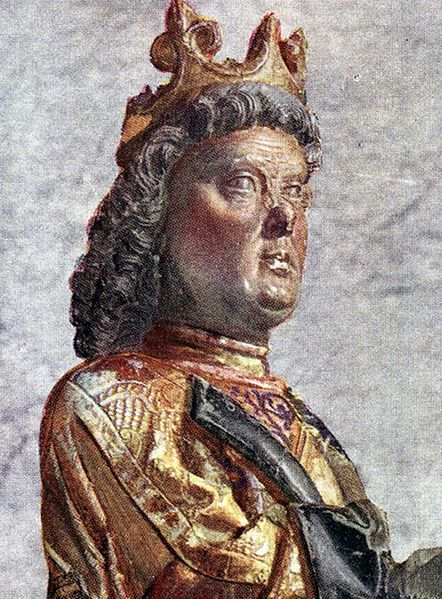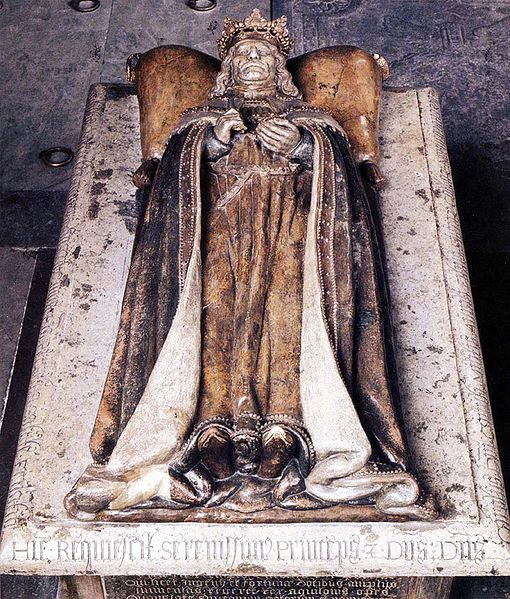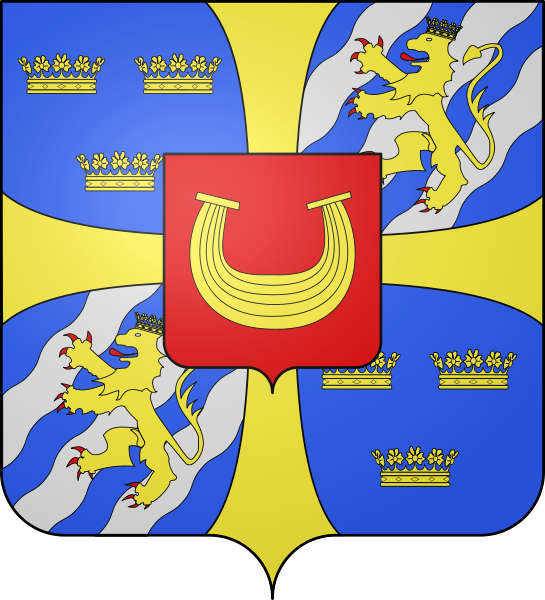<Back to Index>
- King of Sweden and Norway Karl VIII Knutsson, 1409
PAGE SPONSOR



Charles VIII of Sweden (actually Charles II), Charles I of Norway, also Carl, Swedish: Karl Knutsson (Bonde), was king of Sweden (1448 – 1457, 1464 – 1465 and from 1467 to his death in 1470) and king of Norway (1449 – 1450).
Referring to Karl Knutsson as King Charles VIII is a later invention, counting backwards from Charles IX (1604 – 1611), who adopted his numeral after studying a fictitious history of Sweden. Prior to Karl Knutsson, Sweden had only had one king named Karl (Charles). Charles's first queen's tombstone at Vadstena as well as his coins thus correctly refer to him as Charles II.
Karl Knutsson was born in 5 October 1409, at Ekholmen Castle, the son of Knut Tordsson (Bonde), knight and member of the privy council (riksråd), and Margareta Karlsdotter (Sparre av Tofta), the only daughter and heiress of Charles Ulvsson, Lord of Tofta. King Charles died 14 May 1470. His first marriage, in 1428, to Birgitta Turesdotter (Bielke) (died 1436) gave him his daughter Kristina.
His second marriage, in 1438, to Katarina Karlsdotter (Gumsehuvud)
(died in 1450) produced his second daughter Magdalena, who married Ivar Axelsson (Tott).
He also had two children by his third wife (and former mistress)
Kristina Abrahamsdotter, Anna and Karl. His father was said by
contemporary legends to descend from a younger brother of King Eric IX (Saint Eric). His mother, an important heiress, descended from Jarl Charles the Deaf and consequently from some ancient Folkunge earls of Sweden, as well as from a daughter of Canute IV of Denmark and Adela of Flanders.
In 1434 he became member of the Privy Council of Sweden and in October of the same year he assumed one of its most senior offices, Lord High Constable of Sweden, or Riksmarsk. Due to the growing dissatisfaction over King Eric of Pomerania among the Swedish nobility, Charles was in 1436 made Rikshövitsman, an office as Military Governor of the Realm and finally replacing the king as an elected regent from 1438 to 1440, as the result of the rebellion by Engelbrekt Engelbrektsson. During Charles's brief regency, the so called rebellion of David (a peasant rebellion) took place in Finland. Eric of Pomerania was forced to step down from the throne and in 1440 Christopher of Bavaria, was elected king in Sweden, Norway and Denmark. At the coronation of Christopher in September 1441, Charles was dubbed a knight and appointed Lord High Justiciar of Sweden, or Riksdrots. In October he resigned as Lord High Justiciar and resumed his office as Lord High Constable. From 1442 he was the military governor, hövitsman, at Vyborg in Finland (margrave of Viborg).
Charles
acquired extensive fiefs, for example in Western Finland. His first
seat was in Turku. Soon, Christopher's government began to take back fiefs and positions and Charles was forced to give up the castle of Turku. Charles's next seat was the castle of Vyborg,
on Finland's eastern border, where he kept an independent court, taking
no heed of Christopher and exercising his own foreign policy in
relation to such powers in the region as the Hanseatic League, the Russian city of Novgorod and the Teutonic Knights in what are today Estonia and Latvia.
At the death of Christopher in 1448, without a direct heir, Charles was elected king of Sweden on June 20 and on June 28 he was hailed as the new monarch at the Stones of Mora, not far from Uppsala, mostly due to his own military troops being present at the place, against the wishes of regents Bengt and Nils Jönsson (Oxenstierna). The Danish had in September 1448 elected Christian I as their new monarch. A rivalry ensued between Charles and Christian for the throne of Norway, which had also been ruled by Christopher, with both kings gaining support from various factions in the Norwegian Council of the realm. In 1449 a portion of the Norwegian council elected Charles King of Norway, and he was crowned in Nidaros Cathedral in Trondheim on November 20. However, Christian also continued pursuing his claim to Norway. The Swedish aristocracy was reluctant to back Charles in a war against Denmark over Norway, and already in 1450, Charles was forced to relinquish the throne of Norway in favor of Christian.
From
1451, Sweden and Denmark were in state of war against each other.
Because of devastating warring, a growing opposition against Charles
emerged among the nobility in Sweden. The strongest opponent was the
Swedish church which opposed Charles's efforts to concentrate royal and secular power. Other opponents were the family group of Oxenstierna and Vasa (House), which had been on the opposing side in the election of king and lost.
During the next 20 years, Charles was deposed twice, only to regain the throne and reign three times (1448 – 57, 1464 – 65, 1467 – 70).
In 1457, a rebellion took place, led by Archbishop Jöns Bengtsson (Oxenstierna) and a nobleman, Erik Axelsson Tott. Charles went into exile to Danzig (Gdańsk). The two leaders of the revolt took the regency, and organized the election of Christian I of Denmark as king (firstly in Turku, then in Stockholm).
In
1463, King Christian quarreled with the Archbishop because of his
taxation policies. The Archbishop was imprisoned, which resulted in a
rebellion by his relatives, and led to Christian being driven out of
Sweden. Charles was recalled by the rebels and returned at the head of a
force of German and Polish mercenaries. Upon arrival in Sweden he found
himself at war with the Archbishop and after two bloody battles in the
winter of 1464 – 1465 Charles was again exiled. In 1467, the regent Erik
Axelsson Tott, now having reverted to support Charles, once more had him
crowned. Charles then reigned for three years, sharing power with the
riksråd, until his death in Stockholm in May 1470.
His children were: With Birgitta Turesdotter (Bielke): Ture Karlsson (Bonde) (dead young before 1447) and Christina Karlsdotter (Bonde) (ca 1432 - before 1500), married 1446 to the noble, councillor and courtier Erik Eriksson (Gyllenstierna). With Catherine of Bjurum: Margaret Karlsdotter (Bonde) (1442 – 1462); Magdalen Karlsdotter (Bonde) (1445 – 1495), married to noble Ivar Axelsson (Tott) 1466; Richeza Karlsdotter (Bonde) (born ca. 1445) nun at Vadstena Abbey; Bridget Karlsdotter (Bonde) (1446 – 1469) nun at Vadstena Abbey; four sons who died early. With Kristina Abrahamsdotter: Anna Karlsdotter (Bonde), married to the noble Håkan Svensson (Bölja), governor of Västerås castle; Charles Bonde (Karlsson) (1465 – 1488).
He left only one young son, born of his mistress, Kristina Abrahamsdotter whom
he married on his deathbed. Though she was recognized as Queen, the
Swedish government did not allow the boy, suddenly legitimized as Prince
Charles (Karl Karlsson) to succeed him, but appointed one of their
number, Sten Sture the Elder (who was Charles's nephew) as regent.
Charles represented a growing nationalist tendency among the Swedish aristocracy which tried first to subjugate the other Scandinavian countries under Sweden but soon focused on dissolving the Kalmar Union. In the next century, when the union was finally dissolved, Charles received some respect as an early champion of Swedish independence.
Charles's fight for power and kingship was more successful than his experience thereof. He allegedly recognized this himself and described his life in a brief poem:
When I was Lord of Fågelvik, (pronounced: foegle - veek)
Then I had wealth and might unique.
But once I was King of the Swedish land,
I was a poor and unhappy man.
Charles's great - granddaughter Christina Nilsdotter Gyllenstierna was married to Sten Sture the Younger whose regency represented similar values: nationalism and Swedish independence.
Though the Bonde family, not descendants of Charles himself but just his collateral relatives, remained prominent among the Swedish nobility and in politics into the 20th Century, Charles's own descendants did not ascend nor inherit any thrones until Prince Christian zu Schleswig - Holstein - Sonderburg - Glucksburg became Christian IX of Denmark in 1863. Charles's descendants have since ascended the thrones of Norway, Greece and Great Britain.
His distant direct descendant, Sibylla of Saxe - Coburg - Gotha married the Hereditary Prince of Sweden in 20th century, and with Sibylla's son, king Carl XVI Gustav of Sweden, Charles's blood returned to the Swedish throne.